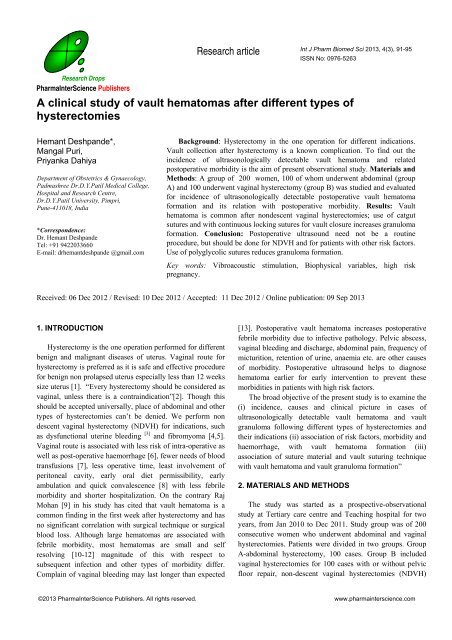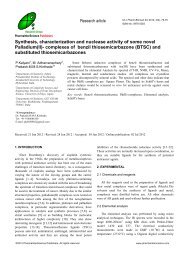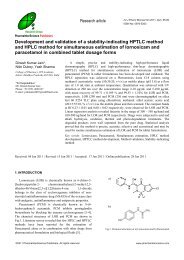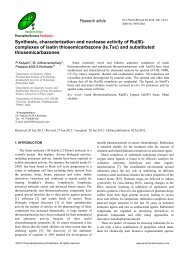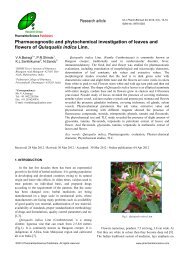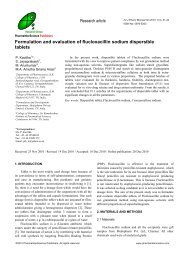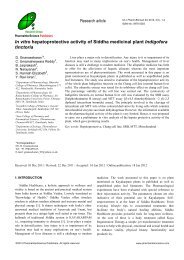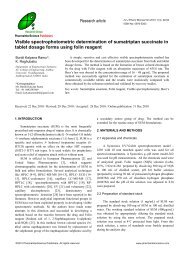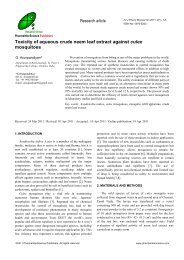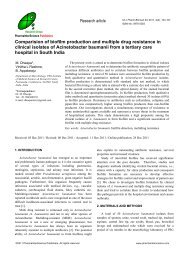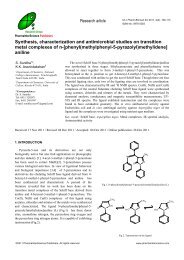A clinical study of vault hematomas after different types of ...
A clinical study of vault hematomas after different types of ...
A clinical study of vault hematomas after different types of ...
You also want an ePaper? Increase the reach of your titles
YUMPU automatically turns print PDFs into web optimized ePapers that Google loves.
Research article<br />
Int J Pharm Biomed Sci 2013, 4(3), 91-95<br />
ISSN No: 0976-5263<br />
Research Drops<br />
PharmaInterScience Publishers<br />
A <strong>clinical</strong> <strong>study</strong> <strong>of</strong> <strong>vault</strong> <strong>hematomas</strong> <strong>after</strong> <strong>different</strong> <strong>types</strong> <strong>of</strong><br />
hysterectomies<br />
Hemant Deshpande*,<br />
Mangal Puri,<br />
Priyanka Dahiya<br />
Department <strong>of</strong> Obstetrics & Gynaecology,<br />
Padmashree Dr.D.Y.Patil Medical College,<br />
Hospital and Research Centre,<br />
Dr.D.Y.Patil University, Pimpri,<br />
Pune-411018, India<br />
*Correspondence:<br />
Dr. Hemant Deshpande<br />
Tel: +91 9422033660<br />
E-mail: drhemantdeshpande @gmail.com<br />
Background: Hysterectomy in the one operation for <strong>different</strong> indications.<br />
Vault collection <strong>after</strong> hysterectomy is a known complication. To find out the<br />
incidence <strong>of</strong> ultrasonologically detectable <strong>vault</strong> hematoma and related<br />
postoperative morbidity is the aim <strong>of</strong> present observational <strong>study</strong>. Materials and<br />
Methods: A group <strong>of</strong> 200 women, 100 <strong>of</strong> whom underwent abdominal (group<br />
A) and 100 underwent vaginal hysterectomy (group B) was studied and evaluated<br />
for incidence <strong>of</strong> ultrasonologically detectable postoperative <strong>vault</strong> hematoma<br />
formation and its relation with postoperative morbidity. Results: Vault<br />
hematoma is common <strong>after</strong> nondescent vaginal hysterectomies; use <strong>of</strong> catgut<br />
sutures and with continuous locking sutures for <strong>vault</strong> closure increases granuloma<br />
formation. Conclusion: Postoperative ultrasound need not be a routine<br />
procedure, but should be done for NDVH and for patients with other risk factors.<br />
Use <strong>of</strong> polyglycolic sutures reduces granuloma formation.<br />
Key words: Vibroacoustic stimulation, Biophysical variables, high risk<br />
pregnancy.<br />
Received: 06 Dec 2012 / Revised: 10 Dec 2012 / Accepted: 11 Dec 2012 / Online publication: 09 Sep 2013<br />
1. INTRODUCTION<br />
Hysterectomy is the one operation performed for <strong>different</strong><br />
benign and malignant diseases <strong>of</strong> uterus. Vaginal route for<br />
hysterectomy is preferred as it is safe and effective procedure<br />
for benign non prolapsed uterus especially less than 12 weeks<br />
size uterus [1]. “Every hysterectomy should be considered as<br />
vaginal, unless there is a contraindication”[2]. Though this<br />
should be accepted universally, place <strong>of</strong> abdominal and other<br />
<strong>types</strong> <strong>of</strong> hysterectomies can’t be denied. We perform non<br />
descent vaginal hysterectomy (NDVH) for indications, such<br />
as dysfunctional uterine bleeding [3] and fibromyoma [4,5].<br />
Vaginal route is associated with less risk <strong>of</strong> intra-operative as<br />
well as post-operative haemorrhage [6], fewer needs <strong>of</strong> blood<br />
transfusions [7], less operative time, least involvement <strong>of</strong><br />
peritoneal cavity, early oral diet permissibility, early<br />
ambulation and quick convalescence [8] with less febrile<br />
morbidity and shorter hospitalization. On the contrary Raj<br />
Mohan [9] in his <strong>study</strong> has cited that <strong>vault</strong> hematoma is a<br />
common finding in the first week <strong>after</strong> hysterectomy and has<br />
no significant correlation with surgical technique or surgical<br />
blood loss. Although large <strong>hematomas</strong> are associated with<br />
febrile morbidity, most <strong>hematomas</strong> are small and self<br />
resolving [10-12] magnitude <strong>of</strong> this with respect to<br />
subsequent infection and other <strong>types</strong> <strong>of</strong> morbidity differ.<br />
Complain <strong>of</strong> vaginal bleeding may last longer than expected<br />
[13]. Postoperative <strong>vault</strong> hematoma increases postoperative<br />
febrile morbidity due to infective pathology. Pelvic abscess,<br />
vaginal bleeding and discharge, abdominal pain, frequency <strong>of</strong><br />
micturition, retention <strong>of</strong> urine, anaemia etc. are other causes<br />
<strong>of</strong> morbidity. Postoperative ultrasound helps to diagnose<br />
hematoma earlier for early intervention to prevent these<br />
morbidities in patients with high risk factors.<br />
The broad objective <strong>of</strong> the present <strong>study</strong> is to examine the<br />
(i) incidence, causes and <strong>clinical</strong> picture in cases <strong>of</strong><br />
ultrasonologically detectable <strong>vault</strong> hematoma and <strong>vault</strong><br />
granuloma following <strong>different</strong> <strong>types</strong> <strong>of</strong> hysterectomies and<br />
their indications (ii) association <strong>of</strong> risk factors, morbidity and<br />
haemorrhage, with <strong>vault</strong> hematoma formation (iii)<br />
association <strong>of</strong> suture material and <strong>vault</strong> suturing technique<br />
with <strong>vault</strong> hematoma and <strong>vault</strong> granuloma formation”<br />
2. MATERIALS AND METHODS<br />
The <strong>study</strong> was started as a prospective-observational<br />
<strong>study</strong> at Tertiary care centre and Teaching hospital for two<br />
years, from Jan 2010 to Dec 2011. Study group was <strong>of</strong> 200<br />
consecutive women who underwent abdominal and vaginal<br />
hysterectomies. Patients were divided in two groups. Group<br />
A-abdominal hysterectomy, 100 cases. Group B included<br />
vaginal hysterectomies for 100 cases with or without pelvic<br />
floor repair, non-descent vaginal hysterectomies (NDVH)<br />
©2013 PharmaInterScience Publishers. All rights reserved. www.pharmainterscience.com
Hemant Deshpande et al, Int J Pharm Biomed Sci 2013, 4(3), 91-95<br />
92<br />
Table 1<br />
Indications for abdominal and vaginal hysterectomies<br />
Abdominal hysterectomy<br />
Vaginal hysterectomy<br />
Indication No. <strong>of</strong> cases No. <strong>of</strong> hematoma case (%) Indication No. <strong>of</strong> cases No. <strong>of</strong> hematoma case (%)<br />
Large multiple fibroids 10 2(20) UV prolapse 70 5(7.14)<br />
Fibroids 15 1(6.67) Fibroid 10 2(20)<br />
DUB 45 0(0) DUB 15 2(13.33)<br />
PID 21 3(14.29) Adenomyosis 5 2(40)<br />
Chronic cervicitis 5 1(20)<br />
Endometriosis 4 0(0)<br />
Total 100 7(7) 100 11(11)<br />
and laparoscopically assisted vaginal hysterectomies<br />
(LAVH), for <strong>different</strong> benign uterine diseases.<br />
Ethical committee permission was obtained for the <strong>study</strong>.<br />
All patients were <strong>clinical</strong>ly evaluated by detail history,<br />
thorough <strong>clinical</strong> examination, and needful investigations<br />
along with pre-operative ultrasound assessment.<br />
Preoperative assessment was done for high risk factors like<br />
hypertension, chronic intake <strong>of</strong> aspirin, ischemic heart<br />
disease, anticoagulant therapy, diabetes mellitus and<br />
coagulopathy for increased bleeding tendencies. After final<br />
diagnosis and indication for hysterectomy, decision regarding<br />
route <strong>of</strong> hysterectomy was decided, to group the patients.<br />
Hysterectomies were performed by <strong>different</strong> experienced<br />
gynaecologists. A single dose <strong>of</strong> intravenous antibiotic,<br />
Injection Cefixime 1 gm was given one hour pre-operatively.<br />
Suture material and suturing technique used for <strong>vault</strong> closure<br />
was recorded. Amount <strong>of</strong> blood loss, units <strong>of</strong> blood<br />
transfused and operative time were recorded for every<br />
patient. Type <strong>of</strong> haemorrhage, if present, was recorded as per<br />
type - primary, reactionary or secondary.<br />
Postoperative morbidity was assessed by complains like<br />
abdominal pain and distension, fever, weakness, bleeding and<br />
foul smelling discharge per vaginum. Postoperative vitals<br />
were noted twice a day in the form <strong>of</strong> pulse rate, temperature<br />
and blood pressure. Daily abdominal examination was<br />
performed for distension, tenderness, guarding and rigidity.<br />
Inspection <strong>of</strong> vulva was done daily for presence <strong>of</strong> any<br />
vaginal discharge. Per speculum examination under aseptic<br />
precautions was performed for the patients complaining <strong>of</strong><br />
bleeding per vaginum.<br />
Transabdominal and transvaginal ultrasound was<br />
performed in each case on 3 rd , 7 th and postoperative days<br />
and if required on subsequent follow up <strong>after</strong> 4 weeks.<br />
The size <strong>of</strong> any <strong>vault</strong> collection (non peristaltic complex<br />
echogenic mass) was noted and classified according to its<br />
mean diameter, i.e. small = 5cm. Patients with a detected pelvic<br />
hematoma were subjected to a follow up ultrasound scan<br />
<strong>after</strong> 7 days and onwards. Patients with large hematoma were<br />
subjected to the evacuation <strong>of</strong> hematoma, in a lithotomy<br />
position, with all aseptic precautions under anaesthesia.<br />
Procedure for draining hematoma was removal <strong>of</strong> central two<br />
sutures <strong>of</strong> the vaginal <strong>vault</strong> and if needed digital exploration<br />
and evacuation. Insertion <strong>of</strong> Penrose drain was considered if<br />
required. Patients with small <strong>hematomas</strong> were treated<br />
conservatively for spontaneous resolution and observed for<br />
any complications. Medium sized <strong>hematomas</strong> were treated<br />
with antifibrinolytic agents like tranaxemic acid with a dose<br />
<strong>of</strong> 500mg eight hourly intravenously or orally. Injectable<br />
antibiotics were added to prevent any superseded infection.<br />
The results were subjected to Chi-square test and Proportion<br />
test for significance.<br />
3. RESULTS<br />
Table 1 shows indications for abdominal and vaginal<br />
hysterectomies. Commonest indication for hysterectomy in<br />
group A was DUB, fibroid uterus and in group B was genital<br />
prolapse.<br />
Incidence <strong>of</strong> <strong>vault</strong> hematoma in our <strong>study</strong> was 11%<br />
following vaginal hysterectomy (VH). Maximum i.e. 45 out<br />
<strong>of</strong> 100 cases <strong>of</strong> abdominal hysterectomies were performed for<br />
DUB, none <strong>of</strong> them developed <strong>vault</strong> hematoma. Incidence <strong>of</strong><br />
<strong>vault</strong> hematoma was 7% <strong>after</strong> abdominal hysterectomy and<br />
it was more in patients who underwent total abdominal<br />
hysterectomies (TAH) for large multiple fibroids. Tyrone<br />
Carpenter reported in his <strong>study</strong>, in around 5% <strong>of</strong> patients,<br />
<strong>vault</strong> haematoma occured following abdominal hysterectomy<br />
[14]. Total laparoscopic hysterectomies (TLH) were<br />
performed in 20 patients, out them, two performed for fibroid<br />
and PID developed hematoma. Incidence <strong>of</strong> hematoma<br />
formation was 7.14% in patients with VH for uterine or<br />
uterovaginal prolapse.<br />
Table 2<br />
Incidence <strong>of</strong> Vault haematoma and granuloma in relation to type <strong>of</strong> VH<br />
Type <strong>of</strong> surgery<br />
©2013 PharmaInterScience Publishers. All rights reserved. www.pharmainterscience.com<br />
No. <strong>of</strong><br />
cases<br />
Vault<br />
hematoma<br />
Vault<br />
granuloma<br />
Abdominal procedures TAH 80 05(6.25%) 13(16.25%)<br />
TLH 20 02(10%) 02(10%)<br />
Total 100 07(7%) 15(15%)<br />
Vaginal procedures VH 20 02(10%) 02(10%)<br />
VH with repair 50 03(6%) 01(10%)<br />
LAVH 10 02(5%) 01(10%)<br />
NDVH 20 04(20%) 01(10%)<br />
Total 100 11(11%) 05(5%)
Hemant Deshpande et al, Int J Pharm Biomed Sci 2013, 4(3), 91-95<br />
Table 2 depicts incidence <strong>of</strong> hematoma and granuloma<br />
formation in relation to surgical procedures. Incidence <strong>of</strong><br />
<strong>vault</strong> granuloma formation in abdominal hysterectomy is<br />
15%. In vaginal procedures it is much less i.e. 5%. 20%<br />
patients who underwent NDVH developed hematoma.<br />
Hematoma and granuloma formation is negligible <strong>after</strong><br />
surgeries done for uterovaginal prolapse. Incidence <strong>of</strong><br />
hematoma <strong>after</strong> LAVH is 5% in our <strong>study</strong>.<br />
Sunanda Bharatnur [15] in her comparative <strong>study</strong> <strong>of</strong><br />
abdominal versus vaginal hysterectomy in nondescent<br />
cases has mentioned that vaginal cuff cellulitis<br />
and <strong>vault</strong> granuloma was 44% in vaginal hysterectomy and<br />
24% in abdominal hysterectomy.<br />
Table 3 shows correlation <strong>of</strong> high risk factors for bleeding<br />
tendencies with <strong>vault</strong> hematoma formation. Incidence is 20%<br />
in patients with hypertension and 15% in patients with<br />
adhesions and 20% in diabetic patients. It is much less i.e.<br />
1.92% in patients without risk factors.<br />
Table 4 shows significant relation (P
Hemant Deshpande et al, Int J Pharm Biomed Sci 2013, 4(3), 91-95<br />
94<br />
hematoma was 19.4%, 70% had small-sized hematoma and<br />
30% had large-sized hematoma. In other studies, incidence <strong>of</strong><br />
postoperative hematoma was detected 25-98% [5,8]. The<br />
incidence <strong>of</strong> <strong>vault</strong> hematoma was found 19.4% in present<br />
<strong>study</strong>. In these patients, 40%(8/20) had fever while only<br />
2.4%(2/83) <strong>of</strong> cases without <strong>vault</strong> hematoma suffered from<br />
fever due to UTI. Study done by Cem Dane et al [17]<br />
indicates out <strong>of</strong> all women having <strong>vault</strong> hematoma,<br />
70%(14/20) had small-sized hematoma and 30% (6/20) had<br />
large-sized hematoma. Fifty percent <strong>of</strong> patients (3/6) with<br />
large-sized hematoma, as compared to only 35%(5/14) with<br />
small-sized hematoma, suffered from febrile morbidity.<br />
Large-sized <strong>hematomas</strong> drained by vaginally, while all smallsized<br />
pelvic <strong>hematomas</strong> managed by watchful expectancy<br />
successfully. The significant difference was found mean<br />
hemoglobin drop and postoperative stay in the hematoma<br />
group or without hematoma group, concluding the<br />
importance <strong>of</strong> sonographic detection <strong>of</strong> vaginal <strong>vault</strong> fluid<br />
collection <strong>after</strong> hysterectomy.<br />
Table 8<br />
Assessment <strong>of</strong> post-operative morbidity parameters in patients with <strong>vault</strong><br />
hematoma<br />
Parameters<br />
Vault hematoma<br />
Present (n=18) Absent (182)<br />
Febrile morbidity 5(27.77%) 1<br />
Drop in hemoglobin 4(5%) 80<br />
Blood transfusion 3(33.33%) 10<br />
Hb drop in g/dL 2.78 averagely 1.24 averagely<br />
Table 9<br />
Relation between size <strong>of</strong> hematoma and post operative morbidity<br />
Small Medium Large<br />
Total no <strong>of</strong> patients 6 7 5<br />
Febrile morbidity 0 3 2<br />
Average Hb drop 1g% 3g% 4g%<br />
Blood transfusion 0 2 1<br />
Mean duration <strong>of</strong> hospital stay 10 days 14 days 20 days<br />
Readmission 0 0 1<br />
Table 10<br />
Relation between suturing technique and <strong>vault</strong> hematoma<br />
Suturing technique Total no <strong>of</strong> cases Hematoma cases (%)<br />
Continuous 100 9(9)<br />
Intermittent 50 1(2)<br />
Continuous locking 50 8(16)<br />
Total 200 18(9)<br />
χ 2 =5.98, P
Hemant Deshpande et al, Int J Pharm Biomed Sci 2013, 4(3), 91-95<br />
comparable with other studies showing 25% patients with<br />
small hematoma and 50% patients with large hematoma had<br />
developed postoperative drop in haemoglobin levels [21]. In<br />
our <strong>study</strong>, 25% <strong>of</strong> patients with small sized hematoma had<br />
negligible morbidity.<br />
All patients undergoing AH or VH alone do not require<br />
routine postoperative pelvic ultrasound scan [22]. But<br />
patients who undergo NDVH, LAVH, patients with<br />
adhesions, presence <strong>of</strong> risk factors and patients with intra &<br />
post-operative haemorrhage should be preferred to be<br />
followed by ultrasound scan. Early diagnosis <strong>of</strong> <strong>vault</strong><br />
hematoma and immediate treatment intervention can reduce<br />
the postoperative morbidity. In this <strong>study</strong> we could identify a<br />
population <strong>of</strong> women at increased risk <strong>of</strong> postoperative<br />
morbidity due <strong>vault</strong> hematoma following hysterectomy.<br />
5. CONCLUSIONS<br />
Routine post operative USG <strong>of</strong> vaginal <strong>vault</strong> on day 5<br />
should be done in all patients undergoing NDVH especially<br />
in hypertensive’s and diabetics and in indications for large<br />
fibroid, endometriosis and chronic PID. Small and medium<br />
<strong>hematomas</strong> resolve by expectant management whereas large<br />
infected <strong>hematomas</strong> need C/S <strong>of</strong> pus and drainage under<br />
anaesthesia. The incidence <strong>of</strong> <strong>vault</strong> <strong>hematomas</strong> is more<br />
following vaginal hysterectomies due to inadequate<br />
hemostasis, infection, high incidence <strong>of</strong> reactionary<br />
haemorrhage and eversion <strong>of</strong> edges <strong>of</strong> vagina during <strong>vault</strong><br />
closure. Incidence <strong>of</strong> granuloma formation can be lowered by<br />
using polyglycolic acid suture material with interrupted<br />
suturing technique for <strong>vault</strong> closure done by experienced<br />
surgeon [22].<br />
REFERENCES<br />
[1] Kumar Sushil, Antony ZK. Vaginal hysterectomy for benign non<br />
prolapsed uterus-Initial experience. J <strong>of</strong> Obstet Gynecol IND 2004, 54,<br />
60.<br />
[2] Qinlan DK. Indication and contraindication. In: Vaginal hysterectomy.<br />
Eds. Shirish Sheth, John Studdm Martin. Dunitz Ltd., London, UK<br />
2002.<br />
[3] Magos A, Bounas N, Sinha R, Rechardson RE. O'Connor H. Vaginal<br />
hysterectomy for the large uterus. Br J Obst Gynaecol 1996, 103, 246.<br />
[4] Sutton CJG. Treatment <strong>of</strong> large uterine fibroids. Br J Obst Gynaecol<br />
1996, 103, 494.<br />
[5] Andersen TF, L<strong>of</strong>t A, Bronnum Hansen H, Roepstorfl’ C, Madsen M.<br />
Complications <strong>after</strong> hysterectomy. Acta Obstet Gynecol Scand 1993,<br />
12, 570.<br />
[6] Hams WJ. Early complications <strong>of</strong> abdominal and vaginal hysterectomy.<br />
Obst Gynec SUN 1995, 50, 795.<br />
[7] Hancock KW, Scott JS. Early discharge following vaginal<br />
hysterectomy. Br J Obstet and Gynaecol 1993, 100, 262.<br />
[8] Kuhn RLP, De Crespigny LC. Vault hematoma <strong>after</strong> vaginal<br />
hysterectomy, an invariable sequel Aust N2 J Obst Gyecol 1985, 25,<br />
59.<br />
[9] Raj Mohan Paspulati, Tejas A Dalal. The journal <strong>of</strong> continuing medical<br />
education in radiology. RadioGraphics 2010, 30, 625.<br />
[10] Hains CJ, Shah YO, Hung TW, Chung TKH, Leung DHY. Sonographic<br />
assessmet<strong>of</strong> the vaginal <strong>vault</strong> following hysterectomy. Acta Obst<br />
Gynecol Scand 1995, 74, 220.<br />
[11] Toglia MR Pearlman MD. Pelvic fluid collections following<br />
hysterectomynand their relation to febrile morbidity. Obst Gynecol<br />
1994, 83, 766.<br />
[12] Slavotinek J, Berman L, Burch D, Keefe B. The incidence and<br />
significance <strong>of</strong> acute pelvic fluid collections. Cli Radiol 1995, 50, 322.<br />
[13] M. Brigid Holloran-Schwartz, Shannon J. Potter, Ming-Shian Kao.<br />
Massive delayed vaginal hemorrhage <strong>after</strong> laparoscopic supracervical<br />
hysterectomy. Case Reports in Obstetrics and Gynecology 2012, Article<br />
ID 871041, 2 pages doi:10.1155/2012/871041<br />
[14] Mr Tyrone Carpenter www.tyronecarpenter.co.uk/procedures/26.htm<br />
[15] Sunanda Bharatnur. Comparative <strong>study</strong> <strong>of</strong> abdominal versus vaginal<br />
Hysterectomy in non-descent cases: The Internet Journal <strong>of</strong> Gynecology<br />
and Obstetrics 2011, 15.<br />
[16] Eason E, Aldis A, Seymour RJ. Pelvic fluid collections by sonography<br />
and febrile morbidity <strong>after</strong> abdominal hysterectomy. Obstetrics &<br />
Gynecology 1997, 90, 158.<br />
[17] Dane C, Dane B, Cetin A, Yayla M. Sonographically diagnosed <strong>vault</strong><br />
<strong>hematomas</strong> following vaginal hysterectomy and its correlation with<br />
postoperative morbidity. Infect Dis Obstet Gynecol 2009, 91708.<br />
[18] Pascal Augustin, Nathalie Kermarrec, Claudette Muller-Serieys,<br />
Sigismond Lasocki, Denis Chosidow. Jean-Pierre Marmuse et al. Risk<br />
factors for multidrug resistant bacteria and optimization <strong>of</strong> empirical<br />
antibiotic therapy in postoperative peritonitis. Critical Care 2010, 14,<br />
R20.<br />
[19] Sunanda Kulkarni, Vijaya N. Detection <strong>of</strong> <strong>vault</strong> hematoma by<br />
ultrasound scan following Hysterectomy and its correlation with<br />
morbidity. J Obstet Gynecol India 2006, 56, 507.<br />
[20] Kansaria JS, Parulekar SV, Gupta AS et al. Ultrasonography for<br />
evaluation <strong>of</strong> pelvic haematomas following vaginal hysterectomy.<br />
Bombay Hosp J 2002, 44, 406.<br />
[21] Haines CJ, Shan YO, Hung TW, Chung TKH and Leung DHY.<br />
Sonographic assessment <strong>of</strong> the vaginal <strong>vault</strong> following hysterectomy.<br />
Acta Obstetricia et Gynecologica Scandinavica 1995, 74. 220.<br />
[22] Morris EP, El-Toukhy T, Toozs-Hobson P, Hefni MA. Refining surgical<br />
technique to prevent occurrence <strong>of</strong> <strong>vault</strong> haematoma <strong>after</strong> vaginal<br />
hysterectomy. Journal <strong>of</strong> Obstetrics and Gynaecology 2001, 21, 379.<br />
95<br />
©2013 PharmaInterScience Publishers. All rights reserved. www.pharmainterscience.com


